Research Topics
Pioneering the field of photonics technology with new semiconductor materials and devices
The fields of technology known as optoelectronics and photonics have made great strides over the past half century and have become indispensable to our daily lives. For example, the development of laser light technology
became the basis for optical fiber communications and high-density optical recording technology, and has greatly advanced the current information society. Various other light-emitting devices such as LEDs, light-receiving devices such
as solar cells and CCDs, and liquid crystals have also been created with various optical functionalities. These fields are still being further developed, and research is being conducted to incorporate more advanced materials and device
technologies.
On the other hand, in recent years, it has become important to apply this highly developed photonics technology to new fields. For example, lightwave and photon technologies are becoming increasingly important as measurement
technologies in medical diagnosis, biological material analysis, and environmental science. For energy and environmental issues, it is also important to deepen our understanding of green energy technologies such as solar cells. Furthermore,
the use of photon states with Bose particle nature is attracting attention as a new quantum computing technology for utilizing big data, and by the time you young people are employed and about to retire, this field may have made great
progress as a replacement for simple electronics.
The goal of this research group is to develop new photonics technology fields based on conventional semiconductor engineering and optoelectronics technologies. Currently, we are focusing on novel photonic devices using organic
molecules and new semiconductor materials called perovskites, and are developing a wide range of research on optoelectronic device technologies such as LEDs, lasers, and solar cells, from exploration of basic physical properties to
investigation of system applications.
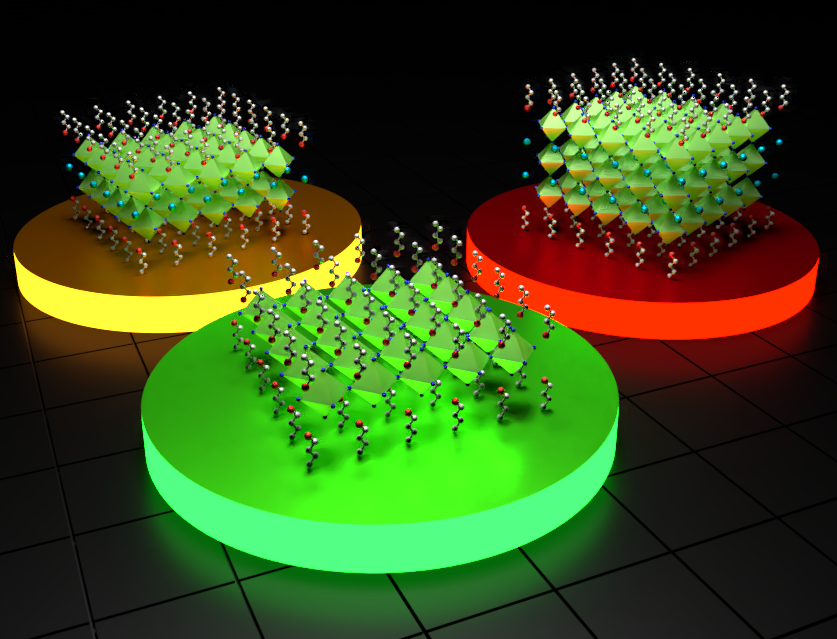 Research Topics
Research Topics
- Room-temperature microcavity polariton
- Organic/perovskite optoelectronic devices
- Broadband Organic Wavelength Tunable Lasers
1. Room-temperature microcavity polariton
In order to fabricate devices for photonics and electronics, it is important to understand the basic physical properties of the materials used and to control their functionality as materials. In the case of small organic molecules and conducting polymers,
they have electronic states called π-conjugated systems, which play an important role in the development of high luminescent and conductive properties. This is quite different from conventional electronics, where it is important to
control the behavior of "carriers" in inorganic semiconductors such as silicon, whereas in organic semiconductors the key is to control "excitons" (pairs of electrons and holes). Organic LEDs and organic solar cells can now be fabricated
by successfully handling the excitonic state. We believe that it is important to improve our technology for controlling the excitonic state in order to realize more advanced devices such as ultra-efficient solar cells and organic semiconductor
lasers in the future.
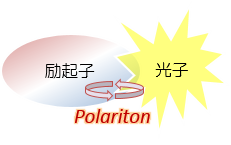 The laboratory is focusing on interaction states with light (photons) as a new control method for excitonic
states. The strongly interacting state between photons and excitons is called polariton, which is half light and half electron (matter). Understanding and controlling the properties of this state precisely
has the potential to significantly change the characteristics of the exciton state, which until now has been difficult to manipulate. In fact, the development of highly functional optoelectronic devices such as lasers has been realized
by skillfully utilizing the interaction between light and matter. A deeper understanding and control of the interaction between light and matter is essential for research and development of new devices using new materials.
The laboratory is focusing on interaction states with light (photons) as a new control method for excitonic
states. The strongly interacting state between photons and excitons is called polariton, which is half light and half electron (matter). Understanding and controlling the properties of this state precisely
has the potential to significantly change the characteristics of the exciton state, which until now has been difficult to manipulate. In fact, the development of highly functional optoelectronic devices such as lasers has been realized
by skillfully utilizing the interaction between light and matter. A deeper understanding and control of the interaction between light and matter is essential for research and development of new devices using new materials.
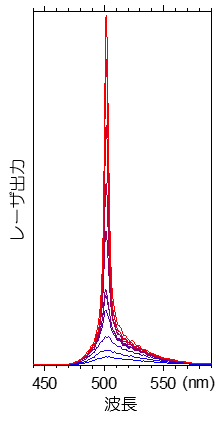 Vertical microcavity laser oscillation of organic molecular single crystals
Vertical microcavity laser oscillation of organic molecular single crystals
Low-molecular-weight organic materials exhibit good semiconductor material properties when crystallized. In particular, crystals of a material system called (thiophene/phenylene) co-oligomer (TPCO) (Figure a below) are known
to have extremely strong luminescence performance (oscillator strength). By using a special TPCO single crystal, we have achieved the first vertical microcavity laser oscillation by an organic crystal. (Figures b and c below) We have
also discovered that this TPCO crystal can achieve an ultrahigh gain of over 1,000 cm-1.
(a)  (b)
(b) 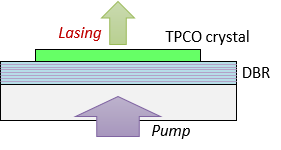 (c)
(c)
Controlling light-matter interactions in organic single-crystal microcavities
As mentioned earlier, the "half light, half matter" properties of polaritons are very attractive for fabricating new next-generation optoelectronic devices, but the exciton-photon interaction must be considerably enhanced to
achieve such a state. To achieve this, it is necessary to devise both the material and the optical properties. In this laboratory, we have succeeded in fabricating a microcavity with a high Q-value using the special TPCO single crystal
described above (Figure a below). This has succeeded in creating a strongly coupled state between a photon and an exciton, thereby realizing the generation of polariton states (Figure b below). We analyzed
the coupling state by fabricating various resonator structures and clarified the parameters that are important for efficient polariton formation.
(a) 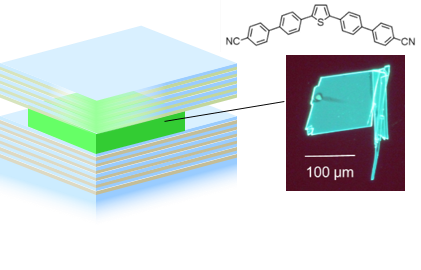 (b)
(b) 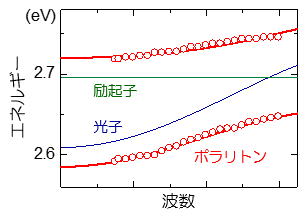
Ultrafast polariton dynamics in organic single-crystal microcavities
One application of this polariton state is known as a laser emission phenomenon based on a new principle called polariton lasing. It is attractive for both academic exploration and device applications, and it is expected that
this phenomenon can be achieved even at room temperature by using organic materials. In collaboration with an overseas institute, we have successfully investigated how this luminescence phenomenon is generated using very fast optical
characterization techniques (ultra-fast time-resolved PL measurement, Figure a below, and transient absorption spectroscopy, Figure b below). This is a very significant achievement because it demonstrates that "strong interactions
with light can be used to change the properties of materials" or, conversely, "interactions with materials can be used to change the properties of light.
(a) 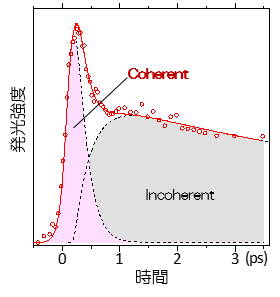 (b)
(b) 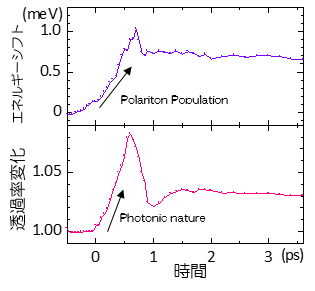
Array fabrication of vertical cavity surface emitting lasers
We are also conducting various studies on device fabrication methods. For example, a vertical-cavity organic laser structure can be fabricated by combining a highly reflective dielectric multilayer mirror with an organic thin
film (see figure a and b below). This type of device can use a semiconductor LD as the pump source, making it possible to create a more practical compact module. We have fabricated a prototype of a multicolor oscillating micro laser
array using a microfabrication technique with photopolymers as the active layer base material (Figure c below). In principle, full colorization and miniaturization are easy.
(a)
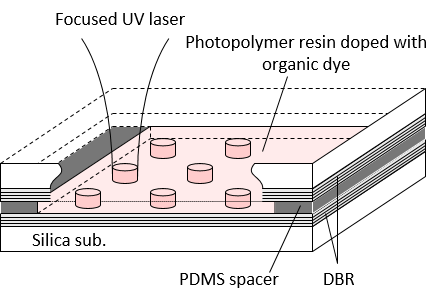 (b)
(b)
 (c)
(c)


Major Research Results
- "Polarization superposition of room-temperature polariton condensation", Y, Moriyama, T. Inukai, T. Hirao, Y. Ueda, S. Takahashi and K. Yamashita, Communications Materials, Vol. 4, No. 110, Dec. 2023, 10.1038/s43246-023-00440-w
- "Drastic transitions of excited state and coupling regime in all-inorganic perovskite microcavities characterized by exciton/plasmon hybrid natures", S. Enomoto, T. Tagami, Y. Ueda, Y. Moriyama, K. Fujiwara, S. Takahashi, and K. Yamashita, Light: Science & Applications,Vol. 11, No. 1, 8, Jan. 2022, 10.1038/s41377-021-00701-8
- "Anisotropic light-matter coupling and below-threshold excitation dynamics in an organic crystal microcavity", T. Tagami, Y. Ueda, K. Imai, S. Takahashi, H. Mizuno, H. Yanagi, T. Obuchi, M. Nakayama, and K. Yamashita, Optics Express, Vol. 29, No. 17, 26433-26443, Aug. 2021, 10.1364/OE.425461.
- "Ultrafast Dynamics of Polariton Cooling and Renormalization in an Organic Single-Crystal Microcavity under Nonresonant Pumping". K. Yamashita, U. Huynh, J. Richter, L. Eyre, F. Deschler, A. Rao, K. Goto, T. Nishimura, T. Yamao, S. Hotta, H. Yanagi, M. Nakayama, and R. H. Friend. ACS Photonics, Vol. 5, , pp. 2182-2188, 2018, 10.1021/acsphotonics.8b00041.
- "Quantitative evaluation of light-matter interaction parameters in organic single-crystal microcavities". T. Nishimura, K. Yamashita, S. Takahashi, T. Yamao, S. Hotta, H. Yanagi, and M. Nakayama. Optics Letters, Vol. 43, No. 5, pp. 1047-1050, 2018, 10.1364/ol.43.001047.
2. Organic/perovskite optoelectronic devices
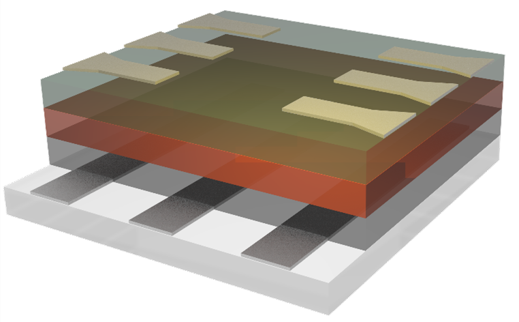 The greatest appeal of organic semiconductor materials is that they can be fabricated using a coating process and
on lightweight, flexible substrates. In addition to this, the recent remarkable progress in material development has led to the high quality of the optical properties of the materials themselves, which has led to the widespread use
of organic LEDs. Recently, lead halide perovskite has also been attracting attention as a new semiconductor material for coating. Our laboratory has also been developing technologies for these dispensable
optoelectronic devices, especially solar cells. Needless to say, further development of power generation technology is important to address various environmental and energy issues. We believe that it is very important for us to study
not only the consumption of electric energy, but also the generation of electric energy, and to have our students learn about such technologies.
The greatest appeal of organic semiconductor materials is that they can be fabricated using a coating process and
on lightweight, flexible substrates. In addition to this, the recent remarkable progress in material development has led to the high quality of the optical properties of the materials themselves, which has led to the widespread use
of organic LEDs. Recently, lead halide perovskite has also been attracting attention as a new semiconductor material for coating. Our laboratory has also been developing technologies for these dispensable
optoelectronic devices, especially solar cells. Needless to say, further development of power generation technology is important to address various environmental and energy issues. We believe that it is very important for us to study
not only the consumption of electric energy, but also the generation of electric energy, and to have our students learn about such technologies.
Fabrication of perovskite solar cells by dry/wet hybrid process
In the fabrication of perovskite solar cells, suppressing damage to the underlying layers during thin film deposition is one of the key issues in improving power conversion efficiency and increasing the number of layers in a solar
cell structure (tandem). To address this issue, we have developed a two-step deposition process, thermal evaporation (dry) and spin-coating (wet), to avoid direct contact of the perovskite precursor solution with the underlying layers
and to fabricate high-quality perovskite thin films (Figure a and b below). Good and stable power generation characteristics have been obtained even under atmospheric conditions (Figure c below).
(a) 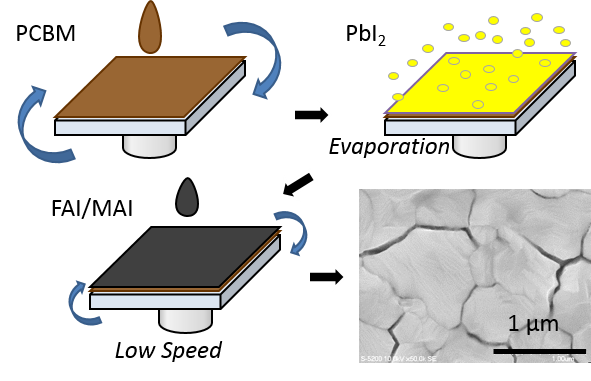 (b)
(b)  (c)
(c) 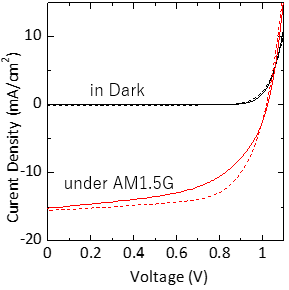
Sensitization of Organic Solar Cells by Dye Doping
The effect of dye doping on the properties of bulk heterojunction solar cell devices with conducting polymer/fullerene derivatives was investigated in detail. We found that a small amount of dye molecules with a certain structure
can induce a change in electronic state that improves the open-circuit voltage (Fig. a and b below).
(a) 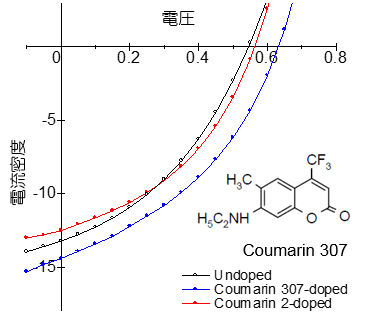 (b)
(b) 
Research Results
- "UV ozone treatment for oxidization of spiro-OMeTAD hole transport layer", R. Hayashi, A. Murota, K. Oka, Y. Inada, and K. Yamashita, RSC Advances, Vol. 13, No. 27, pp. 18561-18567, Jun. 2023, 10.1039/D3RA02315J.
- "Morphological and functional characterizations of SnO2 electron extraction layer on transparent conductive oxides in lead-halide perovskite solar cells", A. Murota, K. Oka, R. Hayashi, K. Fujiwara, T. Nishida, K. Kobayashi, Y. Numata, and K. Yamashita, Applied Physics Letters,Vol. 120, No. 19, 191604, May. 2022, 10.1063/5.0085559.
- "Dry-wet hybrid deposition of wide-bandgap mixed-halide perovskites for tandem solar cell applications", S. Kanbe, J. Kagae, A. Murota, Y. Hara, K. Fujiwara, and K. Yamashita, Applied Physics Letters, Vol. 117, No. 17, 171901, Oct. 2020, 10.1063/5.0029784.
- "Excitation dynamics in layered lead halide perovskite crystal slabs and microcavities", K. Fujiwara, S. Zhang, S. Takahashi, L. Ni, A. Rao, and K. Yamashita, ACS Photonics, Vol. 7, No. 3, pp. 845-852, Mar. 2020, 10.1021/acsphotonics.0c00038.
- "Modification of dry/wet hybrid fabrication method for preparing a perovskite absorption layer on a PCBM electron transport layer", J. Kagae, T. Yamanaka, S. Takahashi, and K. Yamashita, RSC Advances, Vol. 8, No. 68, pp. 39047-39052, Nov. 2018, 10.1039/c8ra08022d.
3. Broadband Organic Wavelength Tunable Lasers
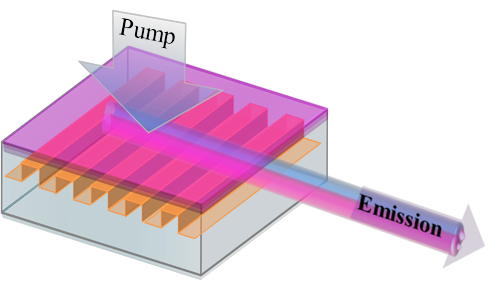 Advances in laser technology have contributed to the development of various fields such as communications, medicine, science and engineering,
and the environment. In particular, analysis technology using light is non-contact and non-destructive, making it extremely useful in the analysis of a wide range of objects, including hazardous substances and living organisms. One
of the key elemental technologies for further advancing this analysis technology is the development of wavelength tunable lasers whose oscillation wavelengths can be continuously or discretely adjusted.
Since a single wavelength tunable laser element can cover multiple oscillation wavelengths, it is expected that equipment and systems can be downsized. Wavelength tunable lasers are also attractive for lighting and display applications,
and research and development is underway.
Advances in laser technology have contributed to the development of various fields such as communications, medicine, science and engineering,
and the environment. In particular, analysis technology using light is non-contact and non-destructive, making it extremely useful in the analysis of a wide range of objects, including hazardous substances and living organisms. One
of the key elemental technologies for further advancing this analysis technology is the development of wavelength tunable lasers whose oscillation wavelengths can be continuously or discretely adjusted.
Since a single wavelength tunable laser element can cover multiple oscillation wavelengths, it is expected that equipment and systems can be downsized. Wavelength tunable lasers are also attractive for lighting and display applications,
and research and development is underway.
We believe that the use of organic materials is a very effective way to realize compact laser devices that can be prepared to oscillate over a wide range of wavelengths. In order to achieve
this, we are conducting research focusing our ideas on both material properties and device design.
Co-doping of organic light-emitting materials for high gain and broadband optical amplification
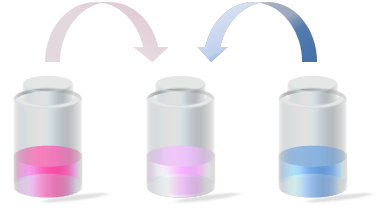 To operate a tunable laser over a wide range of wavelengths, it is first necessary to have materials that exhibit optical gain over a wide range
of wavelengths. To achieve this, it is possible to simply mix materials that exhibit a variety of emission colors with organic materials. In research on organic LEDs, it is common to mix multiple
materials in order to achieve excellent luminescence properties.
To operate a tunable laser over a wide range of wavelengths, it is first necessary to have materials that exhibit optical gain over a wide range
of wavelengths. To achieve this, it is possible to simply mix materials that exhibit a variety of emission colors with organic materials. In research on organic LEDs, it is common to mix multiple
materials in order to achieve excellent luminescence properties.
In our previous research, we have succeeded in expanding the optical gain bandwidth not only by mixing materials, but also by utilizing a new excited state called exciplex (see Figure a below). Exciplex is a dimer formed when
a donor in the excited state combines with an acceptor in the ground state, and in fact, broadband wavelength-tunable laser oscillation has been confirmed (Figure b below).
(a)
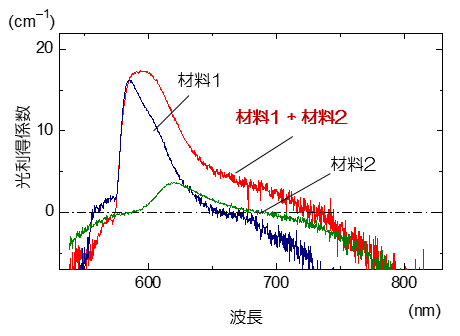 (b)
(b)
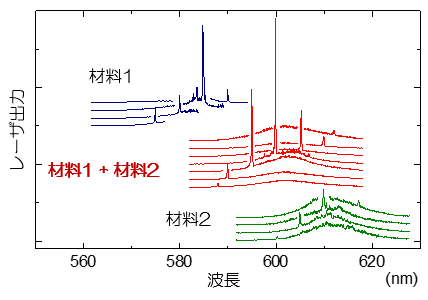
Design of novel wavelength tunable resonator structures using organic materials
In wavelength tunable lasers, narrow single-wavelength oscillation operation and dynamic broadband wavelength tuning are important factors, especially the latter, which is still under development. How efficiently the wavelength
can be changed by external control such as electric power is important. In this laboratory, we are investigating wavelength tunable resonator structures with various structures by applying organic materials that are easy to process
and have material flexibility.
As an example, an asymmetric DBR resonator consisting of a long-period waveguide grating and an organic dye-doped polymer active waveguide is shown (Figure a and b below). In this asymmetric DBR resonator, a large change in oscillation
wavelength can be obtained with a small change in effective refractive index, resulting in efficient wavelength tunability (Figure c below). We have also designed and fabricated various other types of wavelength tunable devices, such
as ring resonators and microcavity resonators.
(a)
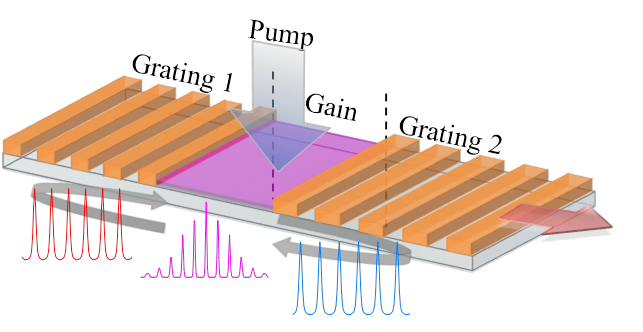 (b)
(b)
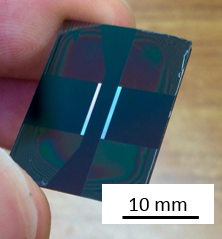 (c)
(c)
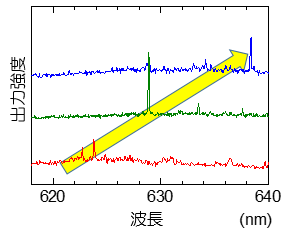
Multi-wavelength integrated laser
Laser devices with multiple operating wavelengths are known to be very useful, but many conventional devices are large, such as a combination of a gas laser and a solid-state laser, making miniaturization a challenge. However,
conventional devices are often large, such as a combination of a gas laser and a solid-state laser, and miniaturization is a challenge. In this laboratory, we focused on flexible organic materials and fabricated a single chip RGB simultaneous
oscillation laser by applying a technique called nanoimprint lithography (see Figure a below). The structure consists of DFB laser layers made of polymer materials doped with different dyes stacked on a SiO2 substrate, and white light
emission from RGB simultaneous laser oscillation by photoexcitation has been achieved (Figure b).
(a)
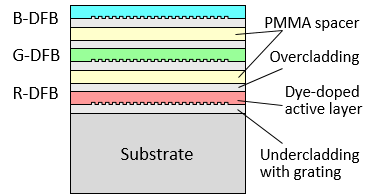 (b)
(b)
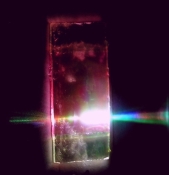 (c)
(c)
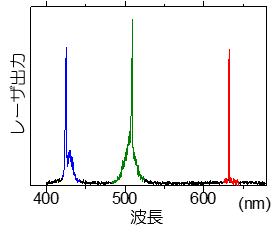
Major Research Results
- "Broadband optical amplification of waveguide cut-off mode in polymer waveguide doped with graphene quantum dots", T. Nagafusa, Y. Hara, K. Nishio, T. Isshiki, and K. Yamashita, Advanced Optical Materials,Vol. 10, No. 10, 2200255, Aug. 2022, 10.1002/adom.202200255.
- "A polymer film with ultra-broadband optical gain characteristics", Y. Hara, Y. Higase, M. Taguchi, S. Takahashi, F. Sasaki, and K. Yamashita, Applied Physics Letters, Vol. 116, No. 6, 063301, Feb. 2020, 10.1063/1.5129477.
- "Compact solid-state organic laser with fine and broadband wavelength tunability", M. Taguchi, Y. Higase, and K. Yamashita, Optics Express, Vol. 27, No. 24/25, pp. 35548-35554, Nov. 2019, 10.1364/OE.27.035548.
- "High-gain and wide-band optical amplifications induced by a coupled excited state of organic dye molecules co-doped in polymer waveguide". Y. Higase, S. Morita, T. Fujii, S. Takahashi, K. Yamashita, and F. Sasaki. Optics Letters, Vol. 43, No. 8, pp. 1714-1717, 2018, 10.1364/ol.43.001714.
- "Simultaneous RGB lasing from a single-chip polymer device". K. Yamashita, N. Takeuchi, K. Oe, and H. Yanagi. Optics Letters, Vol. 35, No. 14, pp. 2451-2453, 2010, 10.1364/ol.35.002451.